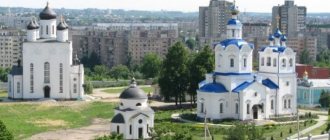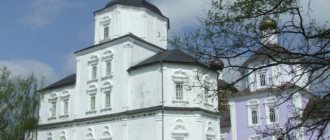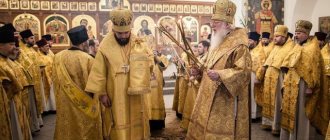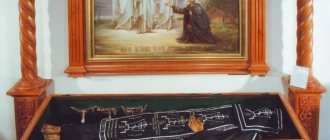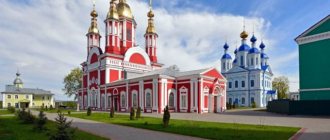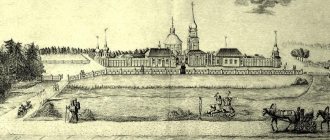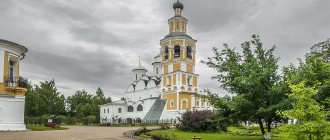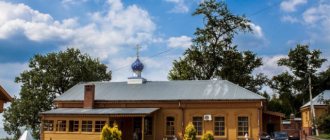Holy places of Russia. Suzdal is a small Russian city in the Vladimir region, with a population of just under 10 thousand people. How beautiful and attractive it is for tourists! The whole day I spent there at the end of May, I was absolutely happy. I haven’t seen so many churches and white-stone chambers for a long time, and I haven’t heard the ringing of a bell.
The first mention of the modern city of Suzdal is found in documentary sources in 1024. The amount of history, interweaving of events and dates is simply breathtaking. You once read about Vasily III, Ivan the Terrible or Vladimir Monomakh, and here you can literally and figuratively touch the history of a great people.
The city of Suzdal is located 25 km north of the city of Vladimir on the Kamenka River and, together with this city and a number of others, is included in the “Golden Ring of Russia” tourist route.
All three photos above and the next couple were taken from the same vantage point. They always try to bring tourists here to introduce them to most of the temples and monasteries that have survived to this day, and there are many of them.
Even at the beginning of the 12th century, under Prince Yuri Dolgoruky, Suzdal was the center of the Rostov-Suzdal principality, and today only temples and cathedrals remember its former greatness.
In 1157, Prince Andrei Bogolyubsky moved the capital from Suzdal to Vladimir. Since the mid-13th century, Suzdal has been the capital of the independent Suzdal principality. At the beginning of the 14th century - the capital of the Suzdal-Nizhny Novgorod principality. In 1392, Suzdal became part of the Grand Duchy of Moscow.
Since the 16th century, monasteries were built in the city, old ones were expanded, and new ones were erected. By this time, there were 11 monasteries in the city (by the beginning of the 19th century, five monastery complexes had survived). Suzdal became one of the religious centers in Rus'.
And today, for an Orthodox believer, Suzdal is a joy for the soul and for the eyes. I was not able to visit all the historical sites and Orthodox shrines, but I still managed to see a lot.
Resurrection Church
This is a summer church built in 1720. Located on the main square of Suzdal, opposite Gostiny Dvor. The Church of the Resurrection is an amazing and rare example of a two-pillar cubic church. It is a towering snow-white single-domed building with smooth facade walls and a bell tower. On the walls and pillars of the temple you can see preserved fragments of paintings from the 18th and 19th centuries.
Once you find yourself near the Church of the Resurrection, you immediately become a witness to the booming trade in souvenir products. It’s difficult to resist shopping, and it’s not necessary. Buy souvenirs and memorable gifts, let them please you for many years!
What would it be like without mead? Which one is not here!
Well, the main souvenirs here are Foxes!
Fraternal (cell) corps
To the right of the Church of the Annunciation there is an L-shaped Brethren building , where in the past the cells of the monks were located. It was built between 1628 and 1660. By the end of the 17th century, 118 brethren lived in the monastery. The second floor was rebuilt in the 19th century. In the southern part, two vaulted floors and walkway balconies have been preserved. The almost 100-meter Brethren building is enlivened by wooden porch galleries that led to the vestibule and cells on both sides and small arched windows with platbands. Nowadays, the premises are given over to the exhibition “History of Suzdal Monasteries”, the restoration museum “Conquering Time” and “The Interweaving of Fates” .
Fraternal (cell) building, southern part
Fraternal (cell) corps
Chains
Museum exhibition
Bells
Museum exhibition
Angel, Leo, Taurus, Eagle - symbols of the evangelists Matthew, Mark, Luke and John, XVIII century. Part of the altar canopy of the rural Church of the Resurrection, Suzdal district
Icon painter's workplace, reconstruction
Bookwriter's workshop, reconstruction
Nun's cell, reconstruction
Pokrovsky Convent
This is a very special place, about which there will be a separate post on the site a little later, but for now I’ll just say that it was founded in 1364 by Prince Dmitry Konstantinovich, and later became a place of imprisonment for representatives of aristocratic families who were tonsured as nuns. Many famous women, each of whom contributed to the development of Russian history, took monastic vows and were transferred to the Intercession Monastery. Now it is active. The rich decoration and ancient buildings attract a large number of tourists who want to admire the beauty of the monastery.
During archaeological excavations on the territory of the monastery in the last century, burials were found, which today were transferred to the tomb.
This is what the summer church of the Intercession Monastery looks like.
And this is how winter is. In past centuries, two temples were often built next door: a larger one for summer, and a smaller one for winter (for ease of heating). In this particular monastery, the summer church is opened after the Orthodox holiday of Trinity, but we were lucky, because... this year the services were moved to the summer church a few days earlier. Thanks to this, I was able to venerate the relics of St. Sophia of Suzdal. And the feast of the Holy Trinity is just today! Congratulations, my readers!
Also on the territory of the Intercession Monastery you can see such wooden log houses. Once upon a time in the 90s these were hotel rooms (the monastery lost its status as a religious shrine for several decades), and today they are places of handicrafts and work for nuns, workshops.
"Golden Pantry"
The Golden Pantry is an exhibition located within the walls of the St. Nicholas Hospital Church, which is part of the Spaso-Evfimiev Monastery. Various works of ancient Russian decorative and applied art are collected here: jewelry, icons, dishes. In total, more than 500 exhibits are exhibited in the “pantry”.
All items in the exhibition have rare value, and not only historical value (some items are more than 1000 years old). Many items are made of silver and gold or richly decorated with natural stones. Every guest of the monastery can visit the exhibition and see how wealthy people of past centuries lived and what the hands of ancient masters were capable of.
St. Nicholas Church
This is a small church made of wood on the territory of the architectural ensemble of the Suzdal Kremlin, which is almost entirely made of stone. The church was built in 1766 in the village of Glotovo, in the Yuryev-Polsky region. In 1960, the church was restored by the architect M.M.Sharonov and transported to Suzdal as the first exhibit of the Museum of Wooden Architecture. Now St. Nicholas Church is one of the most important exhibits of the museum. A unique feature of this building is that not a single nail was used during construction. St. Nicholas Church has a clear silhouette, good proportions of log houses, an exquisite form of its altar, and an elegant dome covered with aspen.
Relics of Saint Arsenios of Elasson
Guests of Suzdal who visited the Assumption Church invariably note its comfort and charm. Some even say that visiting the temple gives a real spiritual and emotional lift. The interior decoration of the church is calming and creates some peace, which allows you not only to enjoy the beauty of the building, but also to indulge in pleasant thoughts, renouncing all worldly worries.
And in 2014, the relics of St. Arsenios of Elasson were delivered to the church. They are available to believers for worship and many go to this temple precisely for this reason.
Having visited the Assumption Church, all guests of the city again find themselves on Kremlevskaya Street, where they complement their positive mood with a pleasant horseback ride or a ride with a real cab driver. This place perfectly conveys the unforgettable atmosphere of the city and allows you to relax your soul surrounded by real history.
We also recommend visiting:
Church of Boris and Gleb
Suzdal Kremlin
This is one of the most ancient places in the city of Suzdal. There we spent a fair amount of time with the tour group and were able to enjoy the amazing architecture of the early 11th century. According to archaeologists, its history begins in the 10th century, according to records in chronicles - from 1024. From an official source: “In the distant 11th – 12th centuries there was a fortress surrounded by earthen ramparts that stretched 1400 meters. On the ramparts there were walls and towers made of logs. The Kremlin housed the prince's court, the prince's squad, and the bishop's court with the city cathedral. Inside the Kremlin there were always a large number of people from the circle of the prince and the bishop. Over the years, the defensive structures were improved and completed, but in 1719 all the wooden fortifications were destroyed in a fire.”
This is the touch.
Closed area
Part of the monastery territory is closed to the public - restoration continues there and there are outbuildings.
Walls of the Spaso-Evfimiev Monastery
Cathedral of the Nativity
Along with the Kremlin, churches, earthen ramparts and ditches belonging to the ancient fortress, the ensemble of the bishop's courtyard and the ancient Nativity Cathedral have been preserved. Oh, this Nativity Cathedral! It was only for him that one could come to Suzdal if there was nothing else to see in this town.
It is one of the monuments of ancient Russian architecture, the most unique of its kind. Now this temple is operational, and at the same time it is part of the Vladimir-Suzdal Museum-Reserve. To get inside, you need to buy a ticket, and you can take photos without restrictions.
The first temple was built in the 11th century, it stood until 1222. The building was then dismantled and rebuilt from white stone. The new temple stood until the 16th century. In 1528, the temple was rebuilt again, and half of the stone was replaced with brick. In the 17th century, the temple was completed with five domes and the walls were painted from the inside. Due to a large number of changes, the temple has survived to this day far from its original form. The decoration of the temple includes beautiful paintings dating back to the 13th, 15th and 17th centuries. There will also be a separate post about this cathedral with a 10-minute video tour.
St. Nicholas Church and Cathedral of the Nativity of the Virgin.
Part of the wall of the Suzdal Kremlin.
St. Basil's Monastery in Suzdal Diocesan monasteries of the Russian Orthodox Church
There is an assumption that the monastery of St. Basil owes its foundation to the holy Equal-to-the-Apostles Prince Vladimir, who, during his stay in Suzdal, enlightened the local residents with holy baptism and erected a temple in honor of his Angel, and thus marked the beginning of the monastic monastery. In support of this opinion, one can cite the fact that all the ancient churches in the name of Basil the Great in cities contemporary with the beginning of Christianity in Russia were founded by Equal-to-the-Apostles Prince Vladimir. These are churches in Kyiv, Ovruch, Vladimir-Volynsky, etc. This assumption is also supported by the special respect for the Vasilyevsky Monastery of the Russian princes and many tsars, expressed in the endowment of its estates. It is interesting that by the 18th century, all the oldest monasteries in Suzdal had already been abolished, except for Vasilievsky and Robozhensky. Even False Dmitry, for violating the letters granted to the Vasilyevsky Monastery, threatens with the death penalty, and Tsar Mikhail Fedorovich calls the abbot and the brethren of the Vasilievsky Monastery “his pilgrims,” and the monastery “his royal pilgrimage.” The monastery had its own courtyard in the Suzdal Kremlin, and this was allowed only to noble monasteries. The courtyard occupied a place between the Suzdal Cathedral and the residences of the Suzdal princes and governors. The monastery had significant land and princely villages - Minskoye, Romanovskoye, and the quitrent village of Vasilyevskoye. In the 17th century, a Stone Chapel, the so-called “Cross”, was added to the monastery, built in memory of the miraculous deliverance of the inhabitants of Suzdal from the pestilence of 1654. Subsequently, churches were built in it in the name of All Saints and St. Nicholas the Wonderworker of Myra. The monastery courtyard in the Kremlin existed until 1719, when it was destroyed by fire and was never restored. If we trace the historical narratives about the disasters of the city of Suzdal: repeated invasions of the Tatars, Poles and Lithuanians, devastating fires, pestilences, then we will be convinced that the Vasilievsky Monastery also suffered many temptations, troubles and sorrows that deprived it of its former significance. The chronicler Ananiy wrote in 1756: “The Vasilievsky Monastery has only arable land from the great princes of Suzhdal, but there are no peasants, except for a few peasants. From the remaining arable land of that monastery, some is plowed for the needs of the monastery, and the latter is given out for rent.” The reforms of 1764 found the Vasilyevskaya Monastery in this situation. The monastery became staffed with maintenance of 300 rubles annually. The number of brethren until the beginning of the 20th century did not exceed 14 people. The abbot of the Vasilievsky Monastery was first abbot, then from 1669 to 1734. - archimandrite, and finally - construction. In 1668, with the blessing of Stephen, Archbishop of Suzdal and Yuryevsk, construction began on the stone cathedral church of St. Basil the Great, patronal feast day January 1/14 n.st. The temple altar is three-part, windows with arched lintels, doors on three sides. The altar is separated from the front part of the temple by a stone wall with three bays. The dome of the temple is supported by two stone pillars. A three-tier bell tower was built on the western side of the Church of St. Basil the Great. Until 1917, the bell tower had bells with a total weight of 170 pounds.
Symmetrical to the Church of St. Basil the Great there is a refectory church in honor of the Presentation of the Vladimir Icon of the Mother of God, patronal feast day September 26/8 n.st. In ancient times it had two chapels below. The building has the shape of a ship, its western part is somewhat wider, and the eastern part is somewhat rounded at the corners. The middle rises above the other parts. Since ancient times, there has been a religious procession in Suzdal from the Nativity of the Mother of God Cathedral in the Kremlin to the Vasilyevsky Monastery on July 23/6, in memory of the deliverance from the pestilence that happened in 1654. At the end of the 18th century, under Archimandrite Varlaam, a stone monastery wall was erected on three sides. In 1860, through the efforts of the hieromonk-builder Theotimos, a large stone two-story building was erected, which housed the abbot's chambers, fraternal cells, a kitchen and a refectory.
Between the churches of St. Basil the Great and the Presentation of Our Lady of Vladimir there was a necropolis. Among the burials, the burial of Christ for the sake of the holy fool Evdokia attracts the most attention. In Suzdal she carried out the feat of foolishness for 50 years and reposed in 1776, bequeathing to be buried within the walls of the Vasilyevsky Monastery, although she labored for half a century in the monastery of St. Euphrosyne. Her memory is revered in Suzdal throughout the following years. Suffice it to say that at the end of the 19th century, in all of Suzdal there was not a single memorial where, along with the Suzdal saints, the name of the blessed maiden Evdokia was not inscribed, and there was not a single funeral liturgy in the city churches, during which, in commemoration of the departed , the name of this holy fool would not be proclaimed several times.
The burial of the headquarters physician Dmitry Pavlovich Morenkov is interesting. At the end of the 18th and beginning of the 19th centuries, he was quite famous in St. Petersburg. For preparing the medicine opodeldok and mint essence, Emperor Alexander I awarded him a gold medal. He moved to Suzdal in 1812 from Moscow, and in 1826 he began producing chicory coffee for general use, prepared according to the method he invented. From the time Morenkov moved to Suzdal until the very day of his death in 1830, he was a true benefactor for the local region, distributing medical and other benefits free of charge to everyone who came to him, and especially to the poor. In 1826, Tsar Nicholas I, for his charity, awarded him the Order of St. Vladimir 4th degree. Dmitry Pavlovich Morenkov has earned the name of a benefactor and friend of a suffering person from Suzdal residents. Further, on the eastern side of the altar are buried: Prince Nikolai Sergeevich Trubetskoy and Princess Ekaterina Petrovna Trubetskaya, née Princess Meshcherskaya. Currently, the necropolis has not survived.
In 1899, by decree of the Holy Synod, the Vasilievsky Monastery was transformed into a women's monastery and assigned to the Deposition of the Robe Convent. In this state, the monastery existed until the revolution of 1917 and, together with other monasteries, was closed.
In 1995, with the blessing of Archbishop Evlogiy, Vladimir and Suzdal, the revival of the St. Basil's Monastery by Abbot Abraham began. Since 2005, the abbot of the monastery has been Abbot Raphael.

